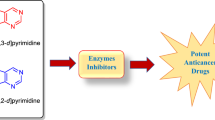Summary
A series of novel 6-fluoro-3-(4-piperidinyl)-1,2-benzisoxazole derivatives 5(a–m) were synthesized with different substituted aromatic/heterocyclic acid chlorides (R-CO-Cl) and characterized by 1H NMR, LC/MS, FTIR and elemental analyses. All the compounds synthesised were evaluated for their antiproliferative activity by 3-(4,5-dimethylthiazol-2-yl)-2,5-diphenyl tetrazolium bromide (MTT) assay. The antiproliferative effects of the synthesised compounds were tested against viable human skin fibroblast cells and carcinoma cells namely HeLa cells, HT-29 cells, MCF-7 cells, HepG-2 cells by adopting positive and negative control. The importance of the aromatic and heterocyclic moiety was confirmed. From the SAR studies, it reveals that, the substitution at N-terminal of 6-fluoro-3-(4-piperidinyl)-1,2-benzisoxazole by the heterocyclic ring plays a dominant role and was responsible for the antiproliferative activity. Among the synthesized compounds 5a, 5d and 5k have showed potent antiproliferative activity on all the carcinoma cells tested.






Similar content being viewed by others
References
Verweij J, Jonge MJA (2000) Achievements and future of chemotherapy. Eur J Cancer 36:1479–1487. doi:10.1016/S0959-8049(00)00133-7
Verdecchia A, Mariotto A, Capocaccia R, Gatta G, Micheli A, Sant M, Berrino F (2001) Incidence and prevalence of all cancerous diseases in Italy: trends and implications. Eur J Cancer 37:1149–1157. doi:10.1016/S0959-8049(01)00094-6
Garret MD, Workman P (1999) Discovering novel chemotherapeutic drugs for the third millennium. Eur J Cancer 35:2010–2030. doi:10.1016/S0959-8049(99)00280-4
Mencher SK, Wang LG (2005) Promiscuous drugs compared to selective drugs (promiscuity can be a virtue). BMC Clin Pharmacol 5:3. doi:10.1186/1472-6904-5-3
Jimeno A, Hidalgo M (2006) Multitargeted therapy: can promiscuity be praised in an era of political correctness. Crit Rev Oncol Hematol 59:150–158. doi:10.1016/j.critrevonc.2006.01.005
Kirk KL, Filler R (1996) In Biomedical Frontiers of Fluorine Chemistry, Symposium Series, vol 639. American Chemical Society, Washington, DC, pp 1–24.
Gelders YG, Heylen SLE, Vander BG, Reyntjens AJM, Janssen PAJ (1990) Pilot clinical investigation of risperidone in the treatment of psychotic patients. Pharmacopsychiatry 23:206–211. doi:10.1055/s-2007-1014509
Dollery C (1999) Therapeutic drugs. Churchill Livingstone, Edinburgh, UK
Park BK, Kitteringham NR (1994) Effects of fluorine substitution on drug metabolism: pharmacological and toxicological implications. Drug Metab Rev 26:605–643. doi:10.3109/03602539408998319
Deng BL, Cullen MD, Zhou Z, Hartman TL, Buckheit RW Jr, Pannecouque C, Clercq ED, Fanwick PE, Cushmana M (2006) Synthesis and anti-HIV activity of new alkenyldiarylmethane (ADAM) non-nucleoside reverse transcriptase inhibitors (NNRTIs) incorporating benzoxazolone and benzisoxazole rings. Bioorg Med Chem 14:2366–2374. doi:10.1016/j.bmc.2005.11.014
Jain M, Kwon CH (2003) 1,2-Benzisoxazole phosphorodiamidates as novel anticancer prodrugs requiring bioreductive activation. J Med Chem 46(25):5428–5436. doi:10.1021/jm020581y
Saunders JC, Williamson WR (1979) Potential antiinflammatory compounds. 2. Acidic antiinflammatory 1,2-benzisoxazoles. J Med Chem 22(12):1554–1558. doi:10.1021/jm00198a026
Nuhrich A, Lembege MV, Vercauteren J, Dokhan R, Renard P, Devaux G (1996) Synthesis and binding affinities of a series of 1,2-benzisoxazole-3-carboxamides to dopamine and serotonin receptors. Eur J Med Chem 31:957–964. doi:10.1016/S0223-5234(97)86174-0
Stiff DD, Robicheau JT, Zemaitis MA (1992) Reductive metabolism of the anticonvulsant agent zonisamide, a 1,2-benzisoxazole derivative. Xenobiotica 22(1):1–11
Clive BP, Scott ES, Phillip SS, Michael RK (1999) Synthesis and evaluation of 6-[11C]Methoxy-3-[2- [1-(phenylmethyl)-4-piperidinyl]ethyl]-1,2-benzisoxazole as an in vivo radioligand for acetylcholinesterase. Nucl Med Biol 26(1):99–103. doi:10.1016/S0969-8051(98)00078-X
Priya BS, Basappa, Swamy SN, Rangappa KS (2005) Synthesis and characterization of novel 6-fluoro-4-piperidinyl-1,2-benzisoxazole amides and 6-fluoro-chroman-2-carboxamides: antimicrobial studies. Bioorg Med Chem 13(7):2623–2628. doi:10.1016/j.bmc.2005.01.026
Chandrappa S, Benaka Prasad SB, Vinaya K, Ananda Kumar CS, Thimmegowda NR, Rangappa KS (2008) Synthesis and In vitro antiproliferative activity against human cancer cell lines of novel 5-(4-methyl-benzylidene)-thiazolidine-2,4-diones. Invest New Drugs 26:437–444. doi:10.1007/s10637-008-9130-7
Ananda Kumar CS, Benaka Prasad SB, Vinaya K, Chandrappa S, Thimmegowda NR Sanjay Swarup, Rangappa KS (2008) Synthesis and antiproliferative activity of substituted diazaspiro hydantoins: a structure–activity relationship study. Invest New Drugs. doi:10.1007/s10637-008-9150-3.
Ananda Kumar CS, Nanjunda Swamy S, Thimmegowda NR, Benaka Prasad SB, George WY, Rangappa KS (2007) Synthesis and evaluation of 1-benzhydryl-sulfonyl-piperazine derivatives as inhibitors of MDA-MB-231 human breast cancer cell proliferation. Med Chem Res 16:179–187. doi:10.1007/s00044-007-9022-y
Ananda Kumar CS, Kavitha CV, Vinaya K, Benaka Prasad SB, Thimmegowda NR, Chandrappa S, Sathees CR, Rangappa KS (2008) Synthesis and antiproliferative activity of substituted diazaspiro hydantoins: a structure–activity relationship study. Invest New Drugs. doi:10.1007/s10637-008-9179-3
Basappa, Mantelingu K, Sadashiva MP, Rangappa KS (2004) A simple and efficient method for the synthesis 1,2-benzisoxazoles: a series of its potent acetylcholinesterase inhibitors. Indian J Chem 43(B):1954–1957
Scudiero DA, Shoemaker RH, Paull KD, Monks A, Tierney S, Nofziger TH, Currens MJ, Seni D, Boyd MR (1988) Evaluation of a soluble tetrazolium/formazan assay for cell growth and drug sensitivity in culture using human and other tumor cell lines. Cancer Res 48:4827–4833
Acknowledgments
The authors are grateful to Council of Scientific and Industrial Research (CSIR), New Delhi for financial support under the project 01(1904)/03/EMR-II 2004, CSIR-SRF to K. Vinaya order No. 09/119(0172)2K8 EMR-I, Elemental Analysis and IR spectroscopic data were obtained from instruments funded by DST-FIST and UGC-SAP (phase I) No.F.540/10/DRS/2004-05 (SAP-I) is greatly acknowledged.
Author information
Authors and Affiliations
Corresponding author
Rights and permissions
About this article
Cite this article
Benaka Prasad, S.B., Vinaya, K., Ananda Kumar, C.S. et al. Synthesis of novel 6-fluoro-3-(4-piperidinyl)-1,2-benzisoxazole derivatives as antiproliferative agents: A structure–activity relationship study. Invest New Drugs 27, 534–542 (2009). https://doi.org/10.1007/s10637-008-9205-5
Received:
Accepted:
Published:
Issue Date:
DOI: https://doi.org/10.1007/s10637-008-9205-5




